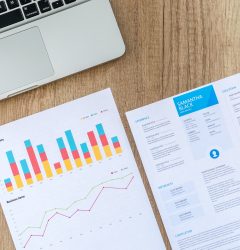We are excited to announce our €2.3 Million Pre-seed round led by Earlybird-X! →
5 steps on how People Analytics helps you build an optimal team
07 Jul

A successful company consists of more than just products and services. The key to success lies in a diverse, strong and effective team. However, putting together the optimal team can be a major challenge. The study “Potential Analysis Agile Decisions” by Sopra Steria Consulting and the F.A.Z. Institute revealed that nine out of ten executives rely heavily (48 percent) or even very heavily (42 percent) on experience and intuition in their decision-making. According to the study, executives in Germany still rely on their gut feeling and make decisions purely intuitively in many cases. In this article, we would like to show how data and analytics can add value and how people analytics can help build a high-performing team.
Step 1: Collect and analyze data
The first step is to collect relevant data about your employees. This can include information on performance, productivity, engagement, retention and diversity. We explain exactly what is behind these metrics in our Metrics Library.
In addition, you can also use other information from documents such as job applications, performance reviews, and employee surveys. By analyzing this data, you can gain a comprehensive picture of each employee and better understand their strengths and weaknesses.
Step 2: Define the requirements
Based on your company’s goals and the requirements of the specific position you want to fill, you need to establish clear criteria for team composition. What skills, experience, and personality traits are important for the role? How diverse is my team compared to other teams and does this affect productivity and creativity?
By using people analytics, you can use objective data to define these requirements and ensure you’re attracting the right people to your team.
Step 3: Identify gaps and potential
People analytics can help you determine if there are gaps in your current team. Perhaps there is a lack of certain skills or there are employees whose performance does not meet the requirements. By identifying these gaps, you can take targeted action to keep your people and talent in your organization for the longer term.
You can read more about how people analytics can help you increase employee retention in your organization here. At the same time, you can also recognize the potential of individual employees and promote them in a targeted manner.
Step 4: Use predictive analytics
People analytics also offers the ability to use predictive analytics, analytics that help you predict future events. By using data, you can make predictions about how new team members are likely to develop. For example, you can figure out which candidate is most likely to be successful in the long term or which employees are at higher risk of leaving the company.
These insights help you make informed decisions and build a stable, high-performing team for the long term.
Step 5: Evaluation and adaptation
The process of building a team is not static. It is important to regularly evaluate whether the team is achieving the desired results and meeting expectations. You can use people analytics to monitor the team’s performance and satisfaction. You can gather feedback from employees to identify areas for improvement. This allows you to take proactive steps to ensure you always have the optimal team staffing.
Using people analytics can be an important tool to help you build the optimal team. By using data and analytics, you can make objective decisions, identify gaps, spot potential, and use predictive analytics. Continuous evaluation and adjustment will allow you to build a team that works together both successfully and harmoniously. Use people analytics to take your business to the next level and achieve long-term success.
Not sure how to get started with People Analytics?
In our blog post What is People Analytics? An Essential Guide to Get Started, we’ve put together a guide to help you get started.
You want to get started?
Get a personalized demo around your unique pain points and discuss your company’s specific needs. Find out how peopleIX can help you on your people analytics journey. Or explore our use cases and learn how you can take people analytics to the next level in your organization in no time.
Recent Posts

Insight: Gender Pay Gap
February 12, 2025
The Challenges of People Analytics
November 12, 2024
People Analytics: Benefits, Origins & Best Practices
November 12, 2024Categories
- Analytics (2)
- Collaboration (1)
- Customer Sucess Stories (1)
- Data Management (1)
- Foundations (9)
- Human Resources (HR) (3)
- Platform (1)
- Recession Times (2)
- Tech Stack (1)
- Uncategorized (7)
- Use Cases (4)
PRODUCT
People Planning & Scenarios
Sharing & Collaboration
RESOURCES
STAY IN THE LOOP
Copyright © 2024 peopleIX GmbH. All rights reserved.


